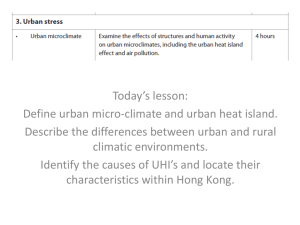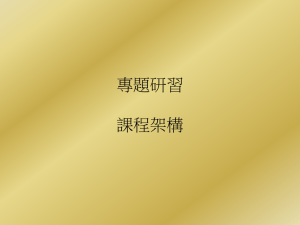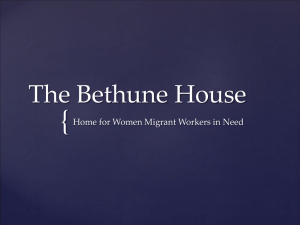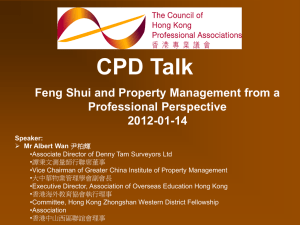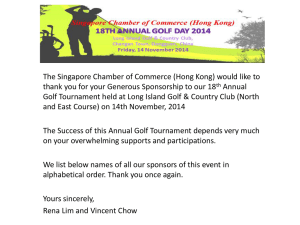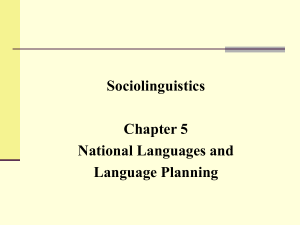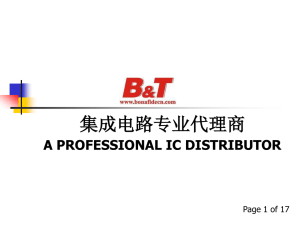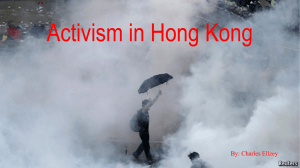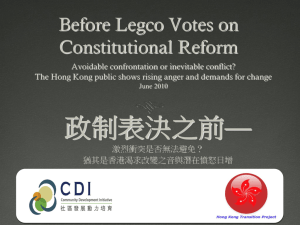Education reform in Hong Kong: Are we going too far?
advertisement
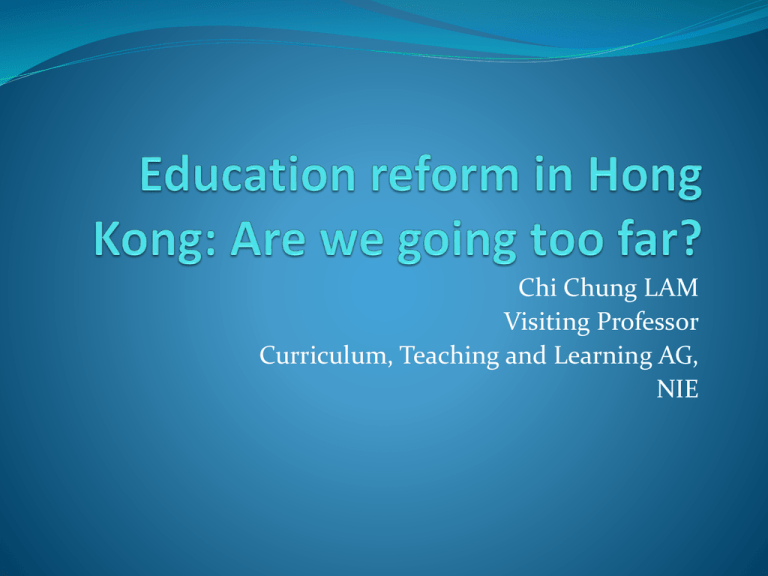
Chi Chung LAM Visiting Professor Curriculum, Teaching and Learning AG, NIE To answer this question What are the changes? What are the outcomes? Sustainability of the system? The changes Curriculum Educational and school management New academic structure (334 reform) The change: Curriculum Learning to learn whole-person development life-long learning emphasis: generic skills life-wide learning Generic skills Collaboration skills Communication skills Creativity Critical thinking skills Information technology skills Numeracy skills Problem-solving skills Self-management skills Study skills 4 key means moral and civic education reading to learn project learning information technology for interactive learning The changes Education and school management: Accountability and managerialism Hold schools and teachers accountable for their work Quality assurance review/ school review Opening up information of school and school performance Participation of the public (parents, alumni, and the public) in school management Induce competition among schools Territory-wide System Assessment (P3, P6 & S3) These scores + School Certificate exam and A-level exam results: value added figures) Academic structure: 334 reform 2004: first proposed 2005: decided to move ahead 2009: implementation at S4 334 reform: change in academic structure From 3.2.2.3 to 3.3.4 i.e. 3 years (lower sec), 2 years (upper sec), 2 years (sixth form/JC), 3 years (undergraduate) To 3 years (lower sec), 3 years (upper sec), 4 years (undergraduate) Only one public examination at the end of secondary education The old system: two exam: school cert (O level) and A-level 12 year: free education The importance of education in the eyes of the parents AND The high level of economic devt: Virtually all students will stay in school after 9 years of compulsory education The major challenge Catering for individual differences Individual differences among students: widening with age (Review of 9 year compulsory education, 1998) The extension of senior secondary education from 2 years to 3 years: means most students will stay on for one more year. Old system: only 40% of the O-level students could proceed to A-level Strategies No streaming All students: 4 core subjects English, Chinese, Mathematics & Liberal Studies Electives: 1-3 traditional academic subjects And/Or Applied Learning subjects What are the impacts of the education reform? Students’ learning outcomes PISA: 2000, 2003, 2006, 2009 2000 Overall, Hong Kong students performed well compared with students in most other countries, ranking first in mathematics, third in science, and sixth in reading among the participating countries. Hong Kong got 560 on the mathematical literacy scale1 , outperforming all the other participating countries significantly except Japan (557) and Korea (547). Hong Kong scored 541 on the scientific literacy scale. Only Korea (552) and Japan (550) performed better than Hong Kong among all the participating countries, but the differences were not statistically significant. On the combined reading scale, Hong Kong obtained a score of 525. Only one country, Finland (546), performed significantly better than Hong Kong. In reading, Canada, New Zealand, Australia and Ireland also performed better than Hong Kong, but the differences were not statistically significant. 2003 2006 Science Finland, with an average of 563 score points, was the highest-performing country Six other high-scoring countries had mean scores of 530 to 542 points: Canada, Japan and New Zealand and the partner countries/economies Hong Kong-China, Chinese Taipei and Estonia. 2006 Reading Korea, with 556 score points, was the highest-performing country in reading. Finland followed second with 547 points and the partner economy Hong Kong-China third with 536 points. Across the OECD area, reading performance generally remained flat between PISA 2000 and PISA 2006. However, two OECD countries (Korea and Poland) and five partner countries/economies (Chile, Liechtenstein, Indonesia, Latvia and Hong KongChina) have seen significant rises in reading performance since PISA 2000. Korea increased its reading performance between PISA 2000 and PISA 2006 by 31 score points, mainly by raising performance standards among the better performing students. Hong Kong-China has increased its reading performance by 11 score points since 2000. 2006 Mathematics Finland and Korea, and the partners Chinese Taipei and Hong Kong-China, outperformed all other countries/economies in PISA 2006. 2009 PISA Hong Kong: Ranking Reading : 4th Math: 3rd Science: 3rd Not only PISA, PIRLS also showed students have improved in reading competency The 4 key areas: i.e. IT, reading, project… Implemented More new school-based curriculum initiatives, in particular in primary schools Classroom teaching: More student-centred methods used Preface to the Progress report on the Edu Reform (4), Dec., 2006 The Education Reform is a mammoth and complex task. Reform proposals spanned across areas which are interrelated. Adjustments in one area may have significant impact on other areas. Changes will inevitably give rise to anxiety, difficulties and challenges. In implementing the reform initiatives, our educators have worked diligently with devotion and commitment. Expected improvements are now gradually taking place in teaching and learning in schools. Our efforts are bearing fruits. The Education and Manpower Bureau and the education sector seem to have sailed through the most difficult period in the establishment of rapport and partnership. Arthur Li (Secretary for Education and Manpower), 2006 So, isn’t the answer to the topic of the presentation very obvious? But: outcomes of a change: More than students’ learning outcomes See for example, Stake’s countenance approach & Stufflebeam’s CIPP model Let’s look at three phenomena before making the final verdict Pressure on teachers 23 Pressure on teachers: increasing Overwork: a committee was set up in 2006 to look into the matter But still very heavy Not only teachers, principals also face similar problem Getting more and more difficult to attract quality young graduates to the profession Teachers’: loss their sense of professional satisfaction They complained that they had been pushed to take up many “non-edu” work Ho, Y.F. (2006) Intensified pressure in secondary schools The introduction of new senior secondary schools Upset the ecology in schools The introduction of Liberal Studies as a compulsory subject: a redundancy of teachers in all subjects Teachers: have to be retrained to take up LS If each school needs 8 teachers, nearly 4000 teachers have to be retrained What is LS? A transdisciplinary subject 6 units: from three areas: Self and personal development Personal development and interpersonal relationships Society and culture Hong Kong Toady Modern China Globalisation Science, technology and the environment Public Health Energy technology & the Environment 27 Use contemporary issues as a platform to: • study contemporary events not covered by any single disciplines (Awareness) • expand knowledge & perspectives beyond single disciplines (Broadening) • connect knowledge and concepts across different disciplines (Connecting & Critical thinking) Chinese Language English Language X1 Issues in Liberal Studies Other Learning Experiences Mathematics X2 X3 28 Liberal Studies Not only subject content knowledge Also new pedagogy: issue-based enquiry learning Centred around generic skills Multiple perspectives Values teaching Assessed in public examination Independent Enquiry Study: school-based assessment 29 Lam & Chan (2011) find: Schools find it difficult to cope with LS Attempt to scale it down For example Assign two or even six teachers to teach one class Independent inquiry study: students are given a limited choice of topics Teachers’ morale and subject identity crisis As good subject teachers are assigned to teach LS, the devt of other subjects is adversely affected The backwash effect of TSA Performance of students in TSA (P3, P6 & S3) counts The data: used to judge and monitor schools’ performance Back to drill and practice a search of the Commercial Press on 31 March, 2011: 125 exercise books for TSA, mostly for P.3 and P.6 http://www.cp1897.com.hk/simple_search_result.php?display_type=simpl eness&page=1&number_per_page=15&sort_type=&simple_words=%E5%85 %A8%E6%B8%AF%E6%80%A7%E7%B3%BB%E7%B5%B1%E8%A9%95% E4%BC%B0&is_cpStore= Are we going too far?
